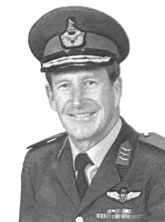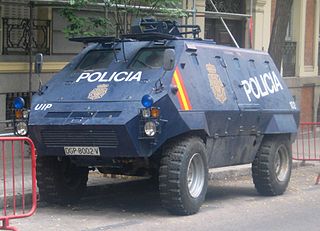
The Selous Scouts was a special forces unit of the Rhodesian Army that operated during the Rhodesian Bush War from 1973 until the reconstitution of the country as Zimbabwe in 1980. It was mainly responsible for infiltrating the black majority population of Rhodesia and collecting intelligence on insurgents so that they could be attacked by regular elements of the security forces. The unit did this by forming small teams that posed as insurgents and usually included captured insurgents. Over time, the Selous Scouts increasingly attacked insurgents themselves and operated in the countries that neighboured Rhodesia.

The British South Africa Police (BSAP) was, for most of its existence, the police force of Southern Rhodesia and Rhodesia. It was formed as a paramilitary force of mounted infantrymen in 1889 by Cecil Rhodes' British South Africa Company, from which it took its original name, the British South Africa Company's Police. Initially run directly by the company, it began to operate independently in 1896, at which time it also dropped "Company's" from its name. It thereafter served as Rhodesia's regular police force, retaining its name, until 1980, when it was superseded by the Zimbabwe Republic Police, soon after the country's reconstitution into Zimbabwe in April that year.

The 1st Battalion, Rhodesian Light Infantry (1RLI), commonly The Rhodesian Light Infantry (RLI), was a regiment formed in 1961 at Brady Barracks as a light infantry unit within the army of the Federation of Rhodesia and Nyasaland. Barely a year after its creation, it was relocated to Cranborne Barracks (Salisbury) where its headquarters remained for the rest of its existence. The Regiment became part of the Southern Rhodesian Army when the Federation dissolved at the start of 1964 and, later that year, reformed into a commando battalion.

The Rhodesian Air Force (RhAF) was an air force based in Salisbury which represented several entities under various names between 1935 and 1980: originally serving the British self-governing colony of Southern Rhodesia, it was the air arm of the Federation of Rhodesia and Nyasaland between 1953 and 31 December 1963; of Southern Rhodesia once again from 1 January 1964; and of the unrecognised nation of Rhodesia following its Unilateral Declaration of Independence from Britain on 11 November 1965.

The Rhodesian Special Air Service or Rhodesian SAS was a special forces unit of the Rhodesian Army. It comprised:

Air Marshal Norman Walsh was a senior officer in the Rhodesian Air Force and the first commander of the Air Force of Zimbabwe.

The Thyssen Henschel UR-416 is a German armoured personnel carrier, first introduced in 1969 and based on the body of the Mercedes-Benz Unimog light truck.

The Rhodesian Armoured Corps, nicknamed the "Black Devils" — was the only standing armoured battalion of the Rhodesian Security Forces. During World War II, it took part in the Allied Spring 1945 offensive and the Battle of Monte Cassino as part of South Africa's 6th Armoured Division. The unit was among the first to enter a liberated Florence in July 1944. Prior to 1963, its crews were trained in the United Kingdom or Aden Colony and were known as the "Selous Scouts" under the Federation of Rhodesia and Nyasaland. After Rhodesia's Unilateral Declaration of Independence, maintaining the armoured vehicle fleet became a responsibility of the Rhodesian Light Infantry until Major Bruce Rooken-Smith reactivated the former Rhodesian Armoured Car Regiment in 1972. During the Rhodesian Bush War, the regiment fought in several major campaigns and battles, particularly Operation Miracle in September 1979. It was superseded by the new Zimbabwe Armoured Corps between 1980 and 1981.

The Rhodesian Security Forces were the military forces of the Rhodesian government. The Rhodesian Security Forces consisted of a ground force, the Rhodesian Air Force, the British South Africa Police, and various personnel affiliated to the Rhodesian Ministry of Internal Affairs. Despite the impact of economic and diplomatic sanctions, Rhodesia was able to develop and maintain a potent and professional military capability.

The Police Support Unit, also known by their nickname of the Black Boots, is a paramilitary wing of the Zimbabwe Republic Police. They were founded as a native police force but later developed into a counter-insurgency unit of the British South Africa Police in Rhodesia during the Rhodesian Bush War. The unit was the only paramilitary unit retained by the Zimbabwe Republic Police after the country's reconstitution as Zimbabwe.

The Ministry of Internal Affairs, commonly referred to as INTAF, was a cabinet ministry of the Rhodesian government. One of Rhodesia's most important governmental departments, it was responsible for the welfare and development of the black African rural population. It played a significant role maintaining control of rural African villages during the Rhodesian Bush War.

The Rhodesia Regiment (RR) was one of the oldest and largest regiments in the Rhodesian Army. It served on the side of the United Kingdom in the Second Boer War and the First and Second World Wars and served the Republic of Rhodesia in the Rhodesian Bush War.
The Bullet Troop-Carrying Vehicle (TCV) is a light 4x4 infantry fighting vehicle (IFV) developed by Rhodesia in the late 1970s based on the body of the Mercedes-Benz Unimog light truck.
The MAP75 Armoured Personnel Carrier is a Rhodesian 4x4 heavy troop-carrying vehicle (TCV) first introduced in 1978 based on a Mercedes-Benz truck chassis. It remains in use with the Zimbabwe National Army.
The MAP45 Armoured Personnel Carrier is a Rhodesian/Zimbabwean 4x4d heavy troop-carrying vehicle (TCV) first introduced in 1978 based on a Mercedes-Benz truck chassis. It remains in use with the Zimbabwe National Army.

The Rhodesian Brushstroke is a brushstroke-type camouflage pattern used by the Rhodesian Security Forces from 1965 until its replacement by a vertical lizard stripe in 1980.

Although many other countries have possessed chemical and biological weapons programs, Rhodesia was one of the few countries known to have used chemical and biological agents. Rhodesian CBW use took place toward the end of Rhodesia's protracted struggle against a growing African nationalist insurgency in the late 1970s. The genesis of the Rhodesian CBW effort emerged as a result of a deteriorating security situation that developed following Mozambique's independence from Portuguese colonial rule. In April 1980, the former colony became the independent country of Zimbabwe.

The Police Anti-Terrorist Unit (PATU) was a paramilitary auxiliary arm of the British South Africa Police (BSAP) in Rhodesia. The unit was founded in 1966. The concept was created for guerrilla bush warfare and the personnel were both black and white policemen. The unit was abolished in 1980 following the dissolution of the BSAP.
The Guard Force was an arm of the Rhodesian Security Forces. Coming under the Ministry of Defence it was organised on similar lines to, but separate from, the Rhodesian Army. The Guard Force was set up from 1975 to provide security to protected villages. These had been established by the Ministry of Internal Affairs to separate black rural civilians from guerillas during the Rhodesian Bush War. Guard Force units took over security duties from Ministry staff.














